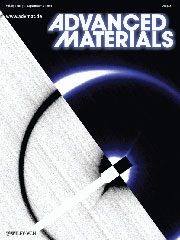- Number 347 |
- October 3, 2011
Amazing electrical properties in polymers

Cover page of Sep. 15 issue of
Advanced Materials showing
scattering patterns for lamellar
block copolymer solutions in the
absence (dark signal on white
background) and presence of an
electric field (light on dark).
Crystals and ceramics pale when compared to a material researchers at DOE's Oak Ridge National Laboratory discovered that has 10 times their piezoelectric effect, making it suitable for perhaps hundreds of everyday uses.
Researchers at ORNL and Technical University Aachen in Germany noticed the reverse piezoelectric effect – defined as creating a mechanical strain by applying an electrical voltage – while conducting fundamental research on polymers. At first they didn't think about their observations in terms of classic piezoelectric materials, but then they became more curious.
"We thought about comparing the effects that we observed to more 'classic' piezoelectric materials and were surprised by how large the effects were by comparison," said Urban, a member of the Department of Energy lab's Neutron Scattering Science Division.
Until now, scientists did not believe that non-polar polymers were capable of exhibiting any piezoelectric effect, which occurs only in non-conductive materials. This research, however, shows up to 10 times the measured electro-active response as compared to the strongest known piezoelectric materials, typically crystals and ceramics.
[Ron Walli, 865.576-0226,
wallira@ornl.gov]
